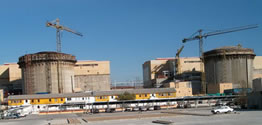
Romanian Nuclear Energy Association- AREN Romania - 60 years of nuclear activity
In 2015, Romania celebrated 60 years of nuclear activity in the country.

|
First nuclear facilities in Romania were a VVRS research reactor (1957) and U120 cyclotron (1959), both Soviet Union made. Today the VVRS reactor is under decommissioning at Horia Hulubei National Institute of Physics and Nuclear Engineering-IFIN HH. From the 1960s, the Romanian scientists managing research in physics encouraged researchers to become involved in the development of the applications of nuclear energy in industry, medicine and in other fields of social life of society. |
Today, IFIN-HH constructs the Extreme Light Infrastructure Nuclear Physics facility (ELI-NP) one of the three pillars of future European ELI which will create a new European laboratory to consistently investigate a very broad range of science domains, from new fields of fundamental physics, new nuclear physics and astrophysics topics, to applications in material science, life sciences and nuclear materials management. |

|
From 1957, Romania participated as a founding country, to all major IAEA initiatives for peaceful use of nuclear energy. Fundamental and applied research from the 1960s in line with world approach to peaceful use of nuclear energy at that time allowed accumulation of proper information that supported the country decision for embarking nuclear power.
The first national nuclear power program was approved in 1968. From the beginning, Romania’s objective was for total energy security. The final option was for CANDU- PHWR reactor type. This option was supported by existing uranium resources and accessible heavy water technology due to established research capacity and tradition in oil and chemistry industry.

|
The first major contract for starting the works on the Cernavoda site in order to construct an NPP with a CANDU design started in 1979. Today, Cernavoda NPP operates Unit 1 (operational since 1996) and Unit 2 (operational since 2007).
|
Within the last 26 years, Romania developed a robust national nuclear system supported by its main components: a legislative and regulatory framework, an independent nuclear safety regulator, a diversified and appreciated research infrastructure supporting both nuclear applications and non-nuclear applications of nuclear energy, and a large spectrum of nuclear license holders using nuclear technology, starting from NPP and nuclear fuel fabrication plant and continuing with the industry, hospitals or medicine. In depth analysis would indicate that there were registered gaps and time delays in finalizing some projects promoting nuclear activities. Romania has welcomed IAEA (starting from the 1960s) and European Commission (during the pre-accession period and when it became an EU Member State in 2007) support in channeling optimum project solutions.
The Institute for Nuclear Research in Pitesti (ICN) was established in 1971. ICN Pitesti had and still has as its main task the maintenance and development of the scientific and technological support for the national nuclear energy program, a vital component in ensuring the sustainable, clean and safe energy for Romania's citizens. The Institute ensures the operation, development and use of its infrastructure (it operates a TRIGA research reactor, examination and testing laboratories, radioactive waste treatment facility, etc.) required to carry-out the research and development programs, education and training of specialists, as well as a sustained international cooperation. ICN promotes the development and application of nuclear technologies in medicine,

|
industry and agriculture adding an important contribution to increasing the citizens' quality of life. ICN Pitesti is a part of the European research projects for Generation IV power reactors (e.g. the Alfred project). |
The Centre of Technology and Engineering for Nuclear Projects CITON has gained and steadily enlarged its experience in project engineering services, design and construction management in the electric power domain starting in the 1970s. CITON performs design and engineering work and assures technical assistance and engineering support for construction – installation, commissioning and operation and maintenance of Cernavoda NPP and other nuclear facilities. CITON as a full-service engineering company and can assist customers with all phases of project implementation including development support and EPC interconnection.
The declarations of the Romanian Government that it supports the continuing development of nuclear activities in Romania are important. Romania has ratified all international conventions on nuclear activities and transposed new European Directives on nuclear safety and spent fuel and radioactive waste management.
A decision making process for 2 new CANDU units on the Cernavoda NPP site is currently supported by the Romanian Government.

|
Romania's nuclear energy program foresees for the safe and competitive operation of Units 1 and 2 of Cernavoda NPP, the completion of Units 3 and 4 Cernavoda NPP, the promotion on the medium and long term of Generation IV advanced reactors, as well as the safe storage and disposal of spent fuel and of radioactive waste. |
The challenges in the development of nuclear activities in Romania, particularly nuclear power development, might be common with those that would be faced by the development of nuclear activities in the European Union. The influence of social, societal or regulating factors might become crucial in this development. The Romanian Nuclear Energy Association (AREN) congratulates the European Nuclear Society (ENS) with the occasion of 40 years of activity and expresses its gratitude on its effective role in promoting the advancement of nuclear activities and supporting its members by a varied portfolio of activities for understanding the challenges and communicating this advancement to the national stakeholders.
|

